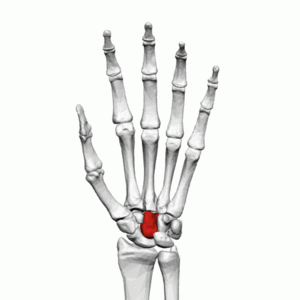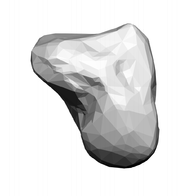Capitate: Difference between revisions
Mande Jooste (talk | contribs) No edit summary |
Leana Louw (talk | contribs) No edit summary |
||
| (21 intermediate revisions by 4 users not shown) | |||
| Line 1: | Line 1: | ||
[{{ | <div class="editorbox"> | ||
'''Original Editor'''- [[User:Mande Jooste|Mande Jooste]] | |||
'''Top Contributors''' - {{Special:Contributors/{{FULLPAGENAME}}}} | |||
</div> | |||
== Description == | |||
Latin: "''Os capitatum"'' | |||
Capitate (derived from the latin word caput<ref>Dictionary.com. Capitate. Available from:https://www.dictionary.com/browse/capitate (accessed 22/02/2019).</ref> that means 'head') is the largest and most central carpal bone, that forms the [[Wrist and Hand|wrist]]. | |||
{| border="0" cellspacing="1" cellpadding="1" | |||
|- | |||
|[[File:Capitate hand.gif|none|thumb]] | |||
|[[File:Capitate_bone.png|thumb|196x196px]] | |||
|} | |||
=== Structure/location === | |||
The capitate can be found in the distal row of carpal bones, where it articulates with the bases of the 2nd and 3rd metacarpal bones forming part of the common carpometacarpal joint. | |||
The carpal bones are connected with inter carpal ligaments and the superiorly the capitate is covered by the flexor retinaculum.<ref>Wadsworth CT. [https://www.jospt.org/doi/abs/10.2519/jospt.1983.4.4.206 Clinical anatomy and mechanics of the wrist and hand.] Journal of Orthopaedic & Sports physical Therapy 1983;4(4):206-216</ref> | |||
== Function == | |||
=== Articulations === | |||
The capitate articulates with seven other bones: | |||
* Proximal surface: [[Scaphoid]] and [[Lunate]] | |||
* Distal surface: base of 2nd and 3rd metacarpal; variably the capitate can also articulate with the base of the 4th metacarpal bone. | |||
* Lateral surface: [[Trapezoid]] | |||
* Medial surface: [[Hamate]] | |||
=== Muscle attachments === | |||
M.adductor pollicis; oblique head<ref>Orthopaedics One. Capitate. Available from: https://www.orthopaedicsone.com/x/YQB_/ (accessed 23/02/2019).</ref> | |||
== Clinical relevance == | |||
Due its anatomical location, isolated capitate injuries are uncommon. Fractures can be seen in association with [[Scaphoid Fracture|scaphoid fractures]], [[Colles Fracture|distal radius fractures]] or [[lunate]] injuries.<ref>Titus SJ, Deitche WS. The sport medicine resource manual. Chapter 18. Wrist and Hand fractures. Elsevier, 2008. </ref> | |||
The capitate, similar to the [[scaphoid]] have limited blood flow, vascular necrosis should be ruled out post-injury. | |||
== Clinical features == | |||
Patient will complain of dorsal [[Wrist and Hand|wrist]] pain, which will correspond with tenderness on palpation of the dorsal aspect. Pain can be increased with axial load of the 3rd metacarpal. | |||
= References = | |||
<references /> | |||
[[Category:Anatomy]] | |||
[[Category:Anatomy Project]] | |||
[[Category:Wrist - Anatomy]] | |||
[[Category:Bones]] | |||
[[Category:Wrist - Bones]] | |||
[[Category:Wrist]] | |||
Latest revision as of 21:49, 26 February 2020
Original Editor- Mande Jooste
Top Contributors - Mande Jooste, Kim Jackson, Leana Louw and Nina Myburg
Description[edit | edit source]
Latin: "Os capitatum"
Capitate (derived from the latin word caput[1] that means 'head') is the largest and most central carpal bone, that forms the wrist.
Structure/location[edit | edit source]
The capitate can be found in the distal row of carpal bones, where it articulates with the bases of the 2nd and 3rd metacarpal bones forming part of the common carpometacarpal joint.
The carpal bones are connected with inter carpal ligaments and the superiorly the capitate is covered by the flexor retinaculum.[2]
Function[edit | edit source]
Articulations[edit | edit source]
The capitate articulates with seven other bones:
- Proximal surface: Scaphoid and Lunate
- Distal surface: base of 2nd and 3rd metacarpal; variably the capitate can also articulate with the base of the 4th metacarpal bone.
- Lateral surface: Trapezoid
- Medial surface: Hamate
Muscle attachments[edit | edit source]
M.adductor pollicis; oblique head[3]
Clinical relevance[edit | edit source]
Due its anatomical location, isolated capitate injuries are uncommon. Fractures can be seen in association with scaphoid fractures, distal radius fractures or lunate injuries.[4]
The capitate, similar to the scaphoid have limited blood flow, vascular necrosis should be ruled out post-injury.
Clinical features[edit | edit source]
Patient will complain of dorsal wrist pain, which will correspond with tenderness on palpation of the dorsal aspect. Pain can be increased with axial load of the 3rd metacarpal.
References[edit | edit source]
- ↑ Dictionary.com. Capitate. Available from:https://www.dictionary.com/browse/capitate (accessed 22/02/2019).
- ↑ Wadsworth CT. Clinical anatomy and mechanics of the wrist and hand. Journal of Orthopaedic & Sports physical Therapy 1983;4(4):206-216
- ↑ Orthopaedics One. Capitate. Available from: https://www.orthopaedicsone.com/x/YQB_/ (accessed 23/02/2019).
- ↑ Titus SJ, Deitche WS. The sport medicine resource manual. Chapter 18. Wrist and Hand fractures. Elsevier, 2008.








